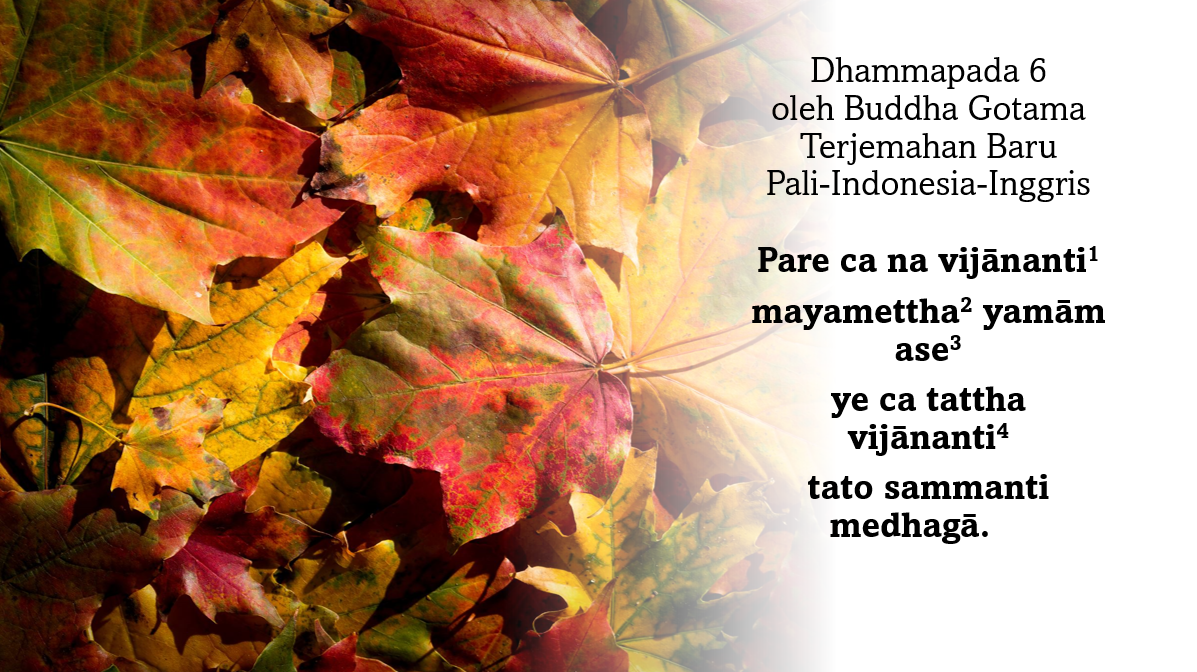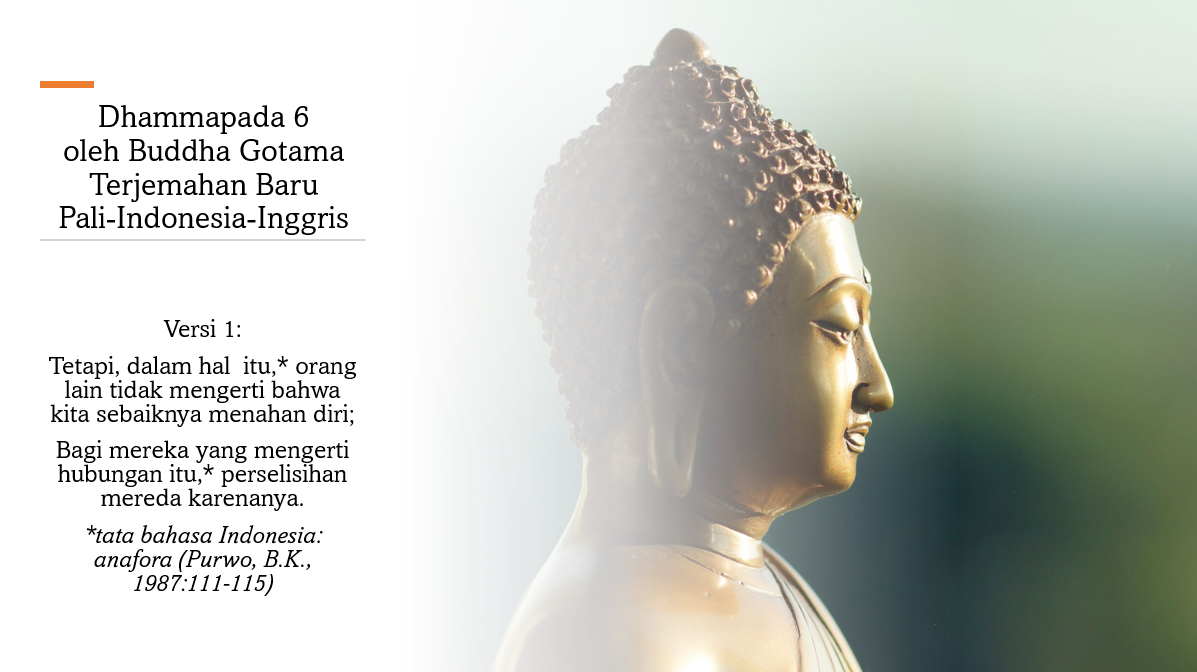Yamaka Vagga



Vocabulary |
pare: (a) (pl. masc. nom.) others, non-Buddhists, aliens to the Buddha’s teaching; (b) derived from para (adj. & noun) ‘other, another’ca: (indef. encl. part.) andna: (indec. part.) no, notvijānanti: (a) (3rd pl. pr. act. indic.) understand, realize; (b); derived from vi- (an intensifying prefix) + √(ñ)ña ‘to know’mayamettha: (a) we in this world, in this world we, in this/that matter we;’ (b) a euphonic union, or sandhi, of mayaṁ (nom. pl. of 1st pron. ahaṁ (I) ‘we’ + ettha (adv.) ‘here, in this world,’ with the niggahīta (ṁ) becoming mye: (a) (those) who; (b) pl.masc.nom.of the relative pron. ya ‘which, who’ca: (indef. encl. part.) andtattha: (indec. adv.) there, in this connectiontato: (abl. sg. of pron. base ta (it) but used here as an indec. adv.)= thereupon, thereafter, hence, then.sammanti: (a) calm down, become quiet; (b) the act. indicative pres. tense for the pl. 3rd. pers. of sammati ‘calms down, becomes quiet’medhagā: (a) strifes; quarrels; (b) pl. masc. nom. of medhaga ‘strife; quarrel’ |
1pare ca na vijānanti: ‘Pare’ means ‘others;’ in this context, people other than the wise. These people do not realize that they must die, and behave as if they were never going to die and keep on quarrelling. Therefore, they are sometimes referred to as the ignorant of the foolish, or those who are not worthy of love and respect (Tin, 1993:3);
2mayamettha: a compound of mayaṁ ‘we’ + ettha ‘now, in this case, in this matter,’ with the niggahīta ṁ becoming m, as it is followed by the vowel e in ettha; other examples: (i) taṁ + atthaṁ= tam atthaṁ; yaṁ + ahu= yam ahu; (iii0 kiṁ + etaṁ= kim etaṁ (Duroiselle, 1915/1997, No. 42). Note: Sometimes, the niggahīta becomes d before certain vowels: (i) etaṁ + attho = etadattho; (ii) etaṁ + eva = etadeva; (iii) etaṁ avoca = etadavoca; (iv) yaṁ + anantaraṁ= yadanantaraṁ (ibid., No. 43);
3.1mayamettha yamamase: (i) lit., “We here must die,” meaning we, of this world, must die; or all mekn are mortal (ibid. p.3); (ii) ettha: here, in this place; also temporal ‘now,’ and modal ‘in this case, in this matter’ (Davids, 1921, Part I, pp. 161-162);
3.2yamᾱmase: (i) the middle first person plural imperative reflective case of yamati ‘to control, to restrain.’ See Davids (1921, Part IV, pp. 8-9); Oberlies (2001:142, 218-21910); and (ii) For the conjugation: Tilbe (1899:73):” The stem vowel -a shall become –ᾱ before –mi, -ma, -hi, and -tha, so that -mase shall become –ᾱmase;” & Duroiselle (1915/1997:122);
(ii) (a)Oberlies (2001:142): As OIA has no indicative present yamate (yamate, RVD 1.127.3, is the subject of the root aorist), the present stem yama- (in: yamāmase, Th 275 = Dhp 6, saṁyamāmase, S I 209,27), cannot be an archaism of Pāli (pace GEIGER § 133). It is a denominative (verb) of yama- ‘restraint’ (see § 51(a’;
(b) Oberlies (2001:218-21910):
A pure indicative value of this ending (or -mase) is postulated by GEIGER (§ 122.2) for abhindāmase ‘we are pleased,’ Vv 156, and tappāmase ‘we are tired,’ Vv 153 But also ohadāmase, Ja II 355,7*, is a statement pure and simple without any ‘imperative’ nuance. The same seems to hold good for jahāmase, Ja VI 550,24*, panudāmase, Ja VI 491,19*, and bhavāmase, Ja VI 567, 10*, Th 1128, and this ending is used also in the future tense (lacchāmase, Vv 320, sikkhissāmase, Sn 814)
The Visudevahindi uses -mahe as 1sg (see ALSDORF, Kleine Schriften p. 59);
(iii) Davids (ibid.) writes:
“Yamati (Yamati} (yam, given in meaning “uparame” i. e. cessation, quieting at Dhtp 226 & Dhtm 322, at the latter with additional “nāse.” On etym. see Walde, Lat. Wtb. s. v. redimio and emo: cp. yanta) to restrain, suppress, to become tranquil; only in stanza Dh 6=Th I.275=J III.488 as 1st pl. med. yamāmase in imper. sense: “pare ca na vijānanti mayaṁ ettha yamāmase,” which is expld both at DhA I.65, Th 1 A, & J III.489 in connection with yama,2 viz. “yamāmase: uparamāma nassāma satataṁ samitaṁ maccu-santikaṁ gacchāmā ti na jānanti,” i. e. let us go continually into the presence of death. A little further at DhA I.66 the expln of it is “bhaṇḍ’- ādīnaṁ vuddhiyā vāyamāmā ti na vijānanti.”
The meaning is “to control oneself,” cp. saṁyamāmase S I.209.
Leop. v. Schroeder, however, trsls. “Und mancher Mann bedenket nicht: wir alle müssen sterben hier” (Worte der Wahrheit, p. 2.). – yameyyātha at S I.217 is wrongly separated from the preceding vā, which ought to be read as vāyameyyātha (so K.S. I.281);”
(iv) Rozehnal (www.buddhism.lib.ntu.tw) writes: “yamāmase: the verb yam- ‘to restrain, to control.’ This form is used only in this place and there is no consensus about its etymology. Probably it is 1st person pl.opt.med.pres. (We should restrain ourselves);
The others do not understand that we should restrain ourselves here.
Those who understand that, therefore appease their quarrels.
But some translate it “We must die” (deriving it from the word yama-, N.m.: death, the god of death).”
(v) Compare it with: (a) saṁyamissanti ‘will control’ in Dhp 37; (b) saṁyamo ‘(who) restrains’ in Dhp.261; (c) Davids (1921, Part I, p.87) & Rozehnal (ibid. in Dhp.307 & 308) write:“asaññatā ‘unrestrained, intemperate, lacking self-control,’ past participle of a+saṁ+yamati.”
4ye ca tattha vijananti: in the case of those who understand, meaning the wise. The wise understand (or realize) that all men are mortal (Tin, 2003:3).
English 1: Burlingame |
English 2: Buddharakhita |
But others do not understand that we must here control ourselves; Yet let them understand this, and straight dissensions cease. |
There are those who do not realize that one day we all must die. But those who do realize this settle their quarrels. |
Indonesia 1: CDD |
Indonesia 2: YDD |
Orang lain (yang berselisih) tidak menyadari bahwa: di sini (dalam perselisihan) kita akan binasa. Namun, mereka yang menyadari akan hal itu, dengan cara demikian segala perselisihan (mereka) akan menjadi reda. |
Masih banyak orang yang tidak mengerti, mengapa kita harus binasa di dunia ini akibat perselisihan. Ia yang memahami kebenaran ini, akan dapat melenyapkan perselisihan. |
From:

About Tjan Sie Tek: https://www.tjansietek.com & https://www.tjansietek.com/test
References:
Pali & English Grammar Books &
25 Comparative English Translations of the Dhammapada
- A. Bhikkhu (2001). Māgadhabhāsa (Pāli): A Compendious Grammar on the Language of Pāli Buddhism. Taiping, Perak Malaysia: Sāsanārakkha Buddhist Sanctuary (SBS)
2. Ānandajoti, Bhikkhu (2017/2019). The Dhammapada: The Sayings of the Buddha. Dundee, Scotland: Evertype
3. Anuruddhācariya, Bhadanta, edited in the Pali and translated by Nārada Mahā Thera into English, 5th edition (1987). A Manual of Abhidhamma. Kuala Lumpur, Malaysia: Buddhist Missionary Society
4. Anuruddha, Kakkapaliye Thera (2004). Dictionary of Pali Idioms, An Aid to The Student of Pali. Hong Kong SAR, China: The Chi Lin Nunnery
5. Bechert, Heinz, and Richard Gombrich (1984). The World of Buddhism. London: Thames and Hudson Ltd. Reprinted in 1995 by Mladinska Knjiga (Slovenia)
6. Bodhi, Bhikkhu (translator) (2020). Reading the Buddha’s Discourses in Pali: A Practical Guide to the Language of the Ancient Buddhist Canon. Two Volumes. Somerville, MA: Wisdom Publications
7. Bomhard, Allan R. (2013). The Dhammapada: The Path of Dhamma. Charleston, SC USA: Charleston Buddhist Fellowship
8. Buddhagosa, Bhadantacariya (1999). The Path of Purification. Translated from the Pali by Bhikkhu Nanamoli. Reprinted in 2003, 2006, 2010. Kandy, Sri Lanka: Buddhist Publication Society
9. Buddharakkita, Acharya (translator) (2014). The Dhammapada. 1st edition. California, USA: Dharma Publishing
10. Burlingame, Eugene Watson (1921). Buddhist Legends: Translated from the Original Pali Text of the Dhammapada Commentary, Three Volumes. Cambridge, MA: Harvard University Press.
11. Carter, John Ross, and Mahinda Paliwahadana (translators) (1987). The Dhammapada, The Sayings of the Buddha. New York, NY: Oxford University Press
12. Clough, Benjamin (1824), softcopy version. Compendious Pali Grammar with a Copious Vocabulary. Colombo, Ceylon: Wesleyan Mission Press
13. Davids, T.W. Rhys (1921/1925). Pali-English Dictionary. London, U.K.: The Pali Text Society
14. Dictionary of the English Language (1996). New York, NY: Random House Value Publishing, Inc.
15. Duroiselle, Charles. 1997. A Practical Grammar of the Pali Language. 3rd edition. Australia: Buddha Dharma Education Association Inc.
16. Easwaran, Eknath (translator) (2007). The Dhammapada. 2nd edition. Petaluma, CA: Nilgiri Press. This is a revised translation
17. Edmunds, Albert J. (1902) (translator). The Hymns of the Faith, Dhammapada: An Ancient Anthology preserved in the Short Collection of the Sacred Scriptures of the Buddhists. Chicago, U.S.A.: The Open Court Publishing Co.
18. Fronsdal, Gil (translator) (2005). The Dhammapada, A New Translation of the Buddhist Classic with Annotations. Boston, MA: Shambhala Publications, Inc.
19. Gair, James W. & Karunatillake, W.S. (1998). A New Course in Reading Pali. Delhi, India: Motilal Banarsidass
20.1 Geiger, Wilhelm, and Mabel Haynes Bode (translators) (1912). The Mahavamsa, The Great Chronicle of Ceylon. London, U.K.: Pali Text Society
20.2 Geiger, Wilhelm (2005). A Pali Grammar. Translated by Batakrishna Ghosh. Revised and Edited by K.R. Norman. London, U.K.: The Pali Text Society
21. Hands, Penny (editor) (2011). Collins Cobuild English Grammar, Third Edition. Glasgow, U.K.: HarperCollins Publishers.
22. Gethin, Rupert (translator) (2008). Sayings of the Buddha. New York, NY: Oxford University Press
23. Lien, Nhu, (2007) (compiler). Kaccāyana Vyakaranaṁ (Kaccāyana’s Pali Grammar). Yangon, Myanmar: Department of Pali, International Theravada Buddhist Missionary University.
24. Millán, Carmen, and Francesca, Bartrina (2013). The Routledge Handbook of Translation Studies. New York, NY: Routledge
24. Müller, Edward (1884). A Simpified Grammar of the Pali Language. Edited by Reinhold Rost. London: TRÜBNER & CO., LUDGATE HILL
26. Müller, F Max (translator) (1898). The Dhammapada. A Collection of Verses. 2nd edition. Revised. Oxford: Clarendon Press
27. Na, Thaw Ba (translator) (2020). M.A. Thesis on the Four Chapters of Dhammapada. Mahaculalongkorn University, Thailand
28. Narada, Thera & Pereira, Cassius A. (translators) (1940). The Dhammapada: The Gift of Truth Excels all Other Gifts. Colombo, Sri Lanka: Mrs W. Leo Fernando
29. Nyānatiloka & Nyānaponika, (1980). Buddhist Dictionary: A Manual of Buddhist Terms & Doctrines. Ceylon, Srilanka: Buddhist Publication Society (BPS)
30. Oberlies, Thomas (2001). Pali, A Grammar of the Language of The TheravadaTipitaka. Edited by Albrecht Wezler and Michael Witzel. Berlin: Walter de Gruyter GmbH & Co.
31. Perniola, Vito (1997). Pali Grammar. Oxford, U.K.: The Pali Text Society
32. Sarada, Maha Thero (translator) (1993), softcopy version. The Illustrated Dhammapada. Treasury of Truth. Australia: Buddha Dharma Education Association Inc.
33. Sarao, K.T.S. (translator) (2009). The Dhammapada: A Translator’s Guide. New Delhi, India: Munshiram Manoharlal Publishers Pvt. Ltd.
34. Shorter Oxford English Dictionary (2002), Fifth Edition. Two Volumes. Oxford, UK: Oxford University Press
35. Tellings, A. Ed. Schmidgall, & Stevens, Alan M. (1981). Contemporary Indonesian English Dictionary. Michigan, USA: Ohio University Press
36. Thomson, A.J., and A.V. Martinet (1986). A Practical English Grammar. Fourth Edition. London, UK: Oxford University Press
37. Tilbe, H.H. (1899). Pali Grammar. Rangoon, Myanmar: American Baptist Mission Press
38. Tin, Daw Mya (translator) (1986). The Dhammapada: Verses & Stories. Edited by the Editorial Committee of the Burma Pitaka Association. Rangoon, Burma: Burma Pitaka Association
39. Vipasanna Graha (undated) (translator). English-Indonesian Dhammapada. West Java: Yayasan Bandung Sucinno Indonesia & Yayasan Banten Dhammaviro
40. Wagiswara, W.D.C. & Saunders, K. James (1912) (translators). The Buddha’s Way of Virtue” A Translation of the Dhammapada from the Pali Text. New York, U.S.A.: E.P. Dutton and Co.
41. Warder, A.K. (2001). An Introduction to Pali Grammar. Oxford, U.K.: The Pali Text Society
42. Woodward F.L. (1923/2013) (translator). The Buddha’s Path of Virtue: A Translation of the Dhammapada. Georgetown, NSW, Australia: Tandava Press
Indonesian Grammar References
- Badudu, J.S .(1986). Inilah Bahasa Indonesia yang Benar I. Jakarta: PT Gramedia
2. Badudu, J.S (1986). Inilah Bahasa Indonesia yang Benar II. Jakarta: PT Gramedia
3. Badudu, J.S. (1989). Inilah Bahasa Indonesia yang Benar III. Jakarta: PT Gramedi.
4. Badudu, J.S. (1986). Inilah Bahasa Indonesia yang Benar IV. Jakarta: PT Gramedia
5. Departemen Pendidikan dan Kebudayaan (1988). Tata Bahasa Buku Indonesia. Jakarta: Perum Balai Pustaka
6. Eddy, Nyoman Tusthi (1987). Analisis Perbandingan Kata dan Istilah Bahasa Malaysia-Indonesia. Flores: Nusa Indah
7. Gonda, J.(1988). Linguistik Bahasa Nusantara: Kumpulan Karya. Jakarta: Balai Pustaka
8. Grijns, C.D.. (1991). Kajian Bahasa Melayu-Betawi. Jakarta: PT Temprint
9. Koewatin, Sasrasoegonda (1986). Kitab Jang Menjatakan Djalannja Bahasa Melajoe. Jakarta: Balai Pustaka
10. Kridalaksana, Harimurti (1988). Beberapa Prinsip Leksem dalam Bahasa Indonesia. Jakarta: Kanisius
11. Loir, Henri Chambert. (2009). Sadur Sejarah Terjemahan di Indonesia dan Malaysia. Jakarta: KPG (Kepustakaan Populer Gramedia)
12. Kridalaksana, Harimurti (1989). Pembentukan Kata Dalam Bahasa Indonesia. Jakarta: PT Gramedia
13. Poerwadarminta, W.J.S. (2002). Kamus Umum Bahasa Indonesia. Jakarta: Balai Pustaka
14. Purwo, Bambang Kaswanti (1984). Deiksis dalam Bahasa Indonesia. Jakarta: Balai Pustaka
15. Pusat Bahasa Departemen Pendidikan Nasional (2000). Pedoman Umum Pembentukan Istilah. Jakarta: Pusat Bahasa
16. Pusat Bahasa Departemen Pendidikan Nasional (2000). Petunjuk Praktis Berbahasa Indonesia. Jakarta: Pusat Bahasa
17. Pusat Bahasa Departemen Pendidikan Nasional (2003). Buku Praktis Bahasa Indonesia. Jilid 1, 2, dan 3. Jakarta: Pusat Bahasa
18. Pusat Bahasa Departemen Pendidikan Nasional (2003). Pengindonesiaan Kata dan Ungkapan Asing. Jakarta: Pusat Bahasa
19. Pusat Pembinaan dan Pengembangan Bahasa Departemen Pendidikan dan Kebudayaan (1991). Kamus Besar Bahasa Indonesia. Jakarta: Balai Pustaka
20. Pusat Pembinaan dan Pengembangan Bahasa (P3B) Departemen Pendidikan dan Kebudayaan (1996). Bahan Penyuluhan Bahasa Indonesia. Jakarta: P3B
21. Setyaningsih, Retno W., dan Rochayah Machali (2017). Topik-Topik dalam Kajian Penerjemahan (Kumpulan Tulisan Yang Sebagian Sudah Pernah Diterbitkan Secara Terpisah). Surabaya: Airlangga University Press
Appendix
Books written by Tjan Sie Tek
Brief Story of the Buddha and Seven Arahants, 2016
Indonesian Essentials for Foreign Students, 1986
Inti Sari Tata Bahasa Inggeris, 2014
English for Buddhist Studies, 2014
In the finalization process:
Practical Advanced English Grammar for Professional Translators and Teachers, and Students and Aspirants of TOEFL, IELTS, and TOEIC Tests. 2022
Books translated from English into Indonesian by Tjan Sie Tek
Bobby Fischer, My 60 Memorable Games. Jakarta: Kantor Penterjemah Resmi Tjan Sie Tek. Jilid 1 dan 2. 1986
In the finalization process:
Sifat Nibbana & Latihan Meditasi Vipassana, YM Mahasi Sayadaw
Himpunan Peraturan untuk Kehidupan,YM Bhikkhu P.A. Payutto. 2022
Buah Karma. Semua Makhluk bergantung pada Perbuatan Masing-Masing. 2022




